MG411: Introduction to People Management in the Retail Sector Report
VerifiedAdded on 2023/01/06
|12
|2544
|22
Report
AI Summary
This report provides an in-depth analysis of people management practices within the retail sector, specifically focusing on TESCO. It begins with an introduction to people management and the contemporary issues faced by line management, such as training and development, and leadership development. The report then delves into the knowledge, skills, and behaviors essential for effective people management, including team building using Tuckman's model and motivational theories like Maslow's hierarchy of needs. Furthermore, it explores HR processes and support management for effective performance management, including goal-setting, control, and social cognitive theories, as well as the 360-degree appraisal method. The report concludes with recommendations for improving management and HR processes, such as developing employee feedback mechanisms, creating detailed job descriptions, and implementing thorough performance evaluations. The report emphasizes the importance of aligning employee contributions with the organization's strategic goals to maximize productivity and professional growth.
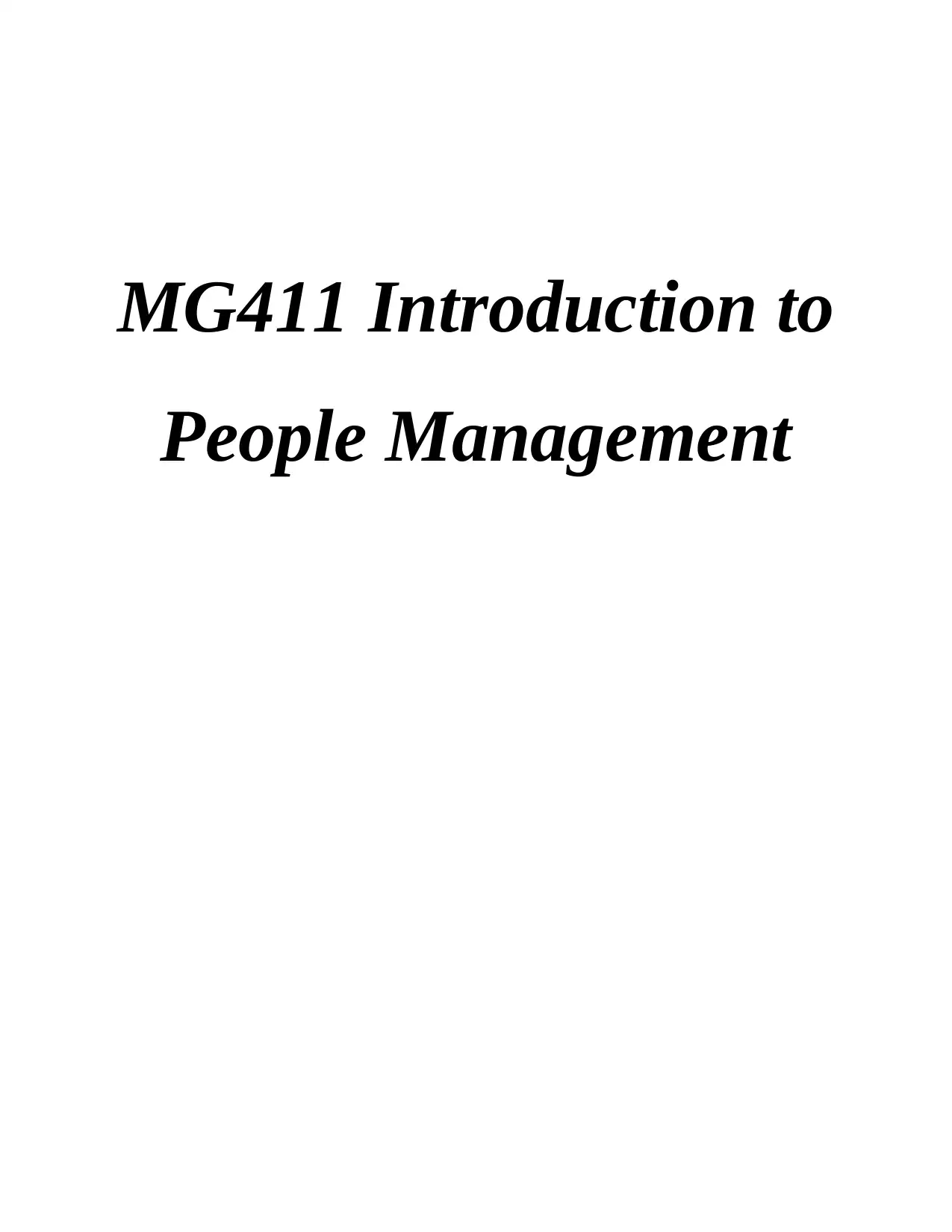
MG411 Introduction to
People Management
People Management
Paraphrase This Document
Need a fresh take? Get an instant paraphrase of this document with our AI Paraphraser
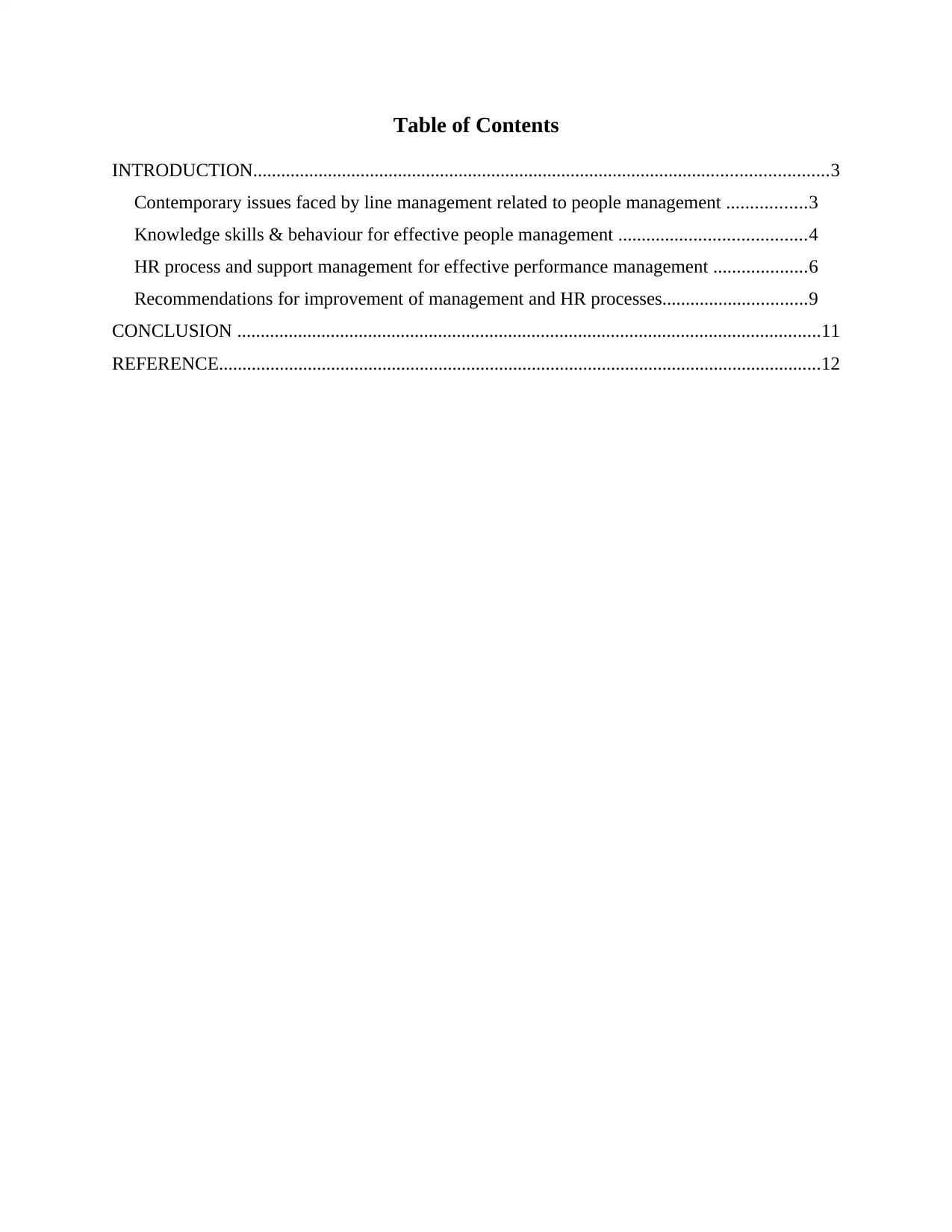
Table of Contents
INTRODUCTION...........................................................................................................................3
Contemporary issues faced by line management related to people management .................3
Knowledge skills & behaviour for effective people management ........................................4
HR process and support management for effective performance management ....................6
Recommendations for improvement of management and HR processes...............................9
CONCLUSION .............................................................................................................................11
REFERENCE.................................................................................................................................12
INTRODUCTION...........................................................................................................................3
Contemporary issues faced by line management related to people management .................3
Knowledge skills & behaviour for effective people management ........................................4
HR process and support management for effective performance management ....................6
Recommendations for improvement of management and HR processes...............................9
CONCLUSION .............................................................................................................................11
REFERENCE.................................................................................................................................12
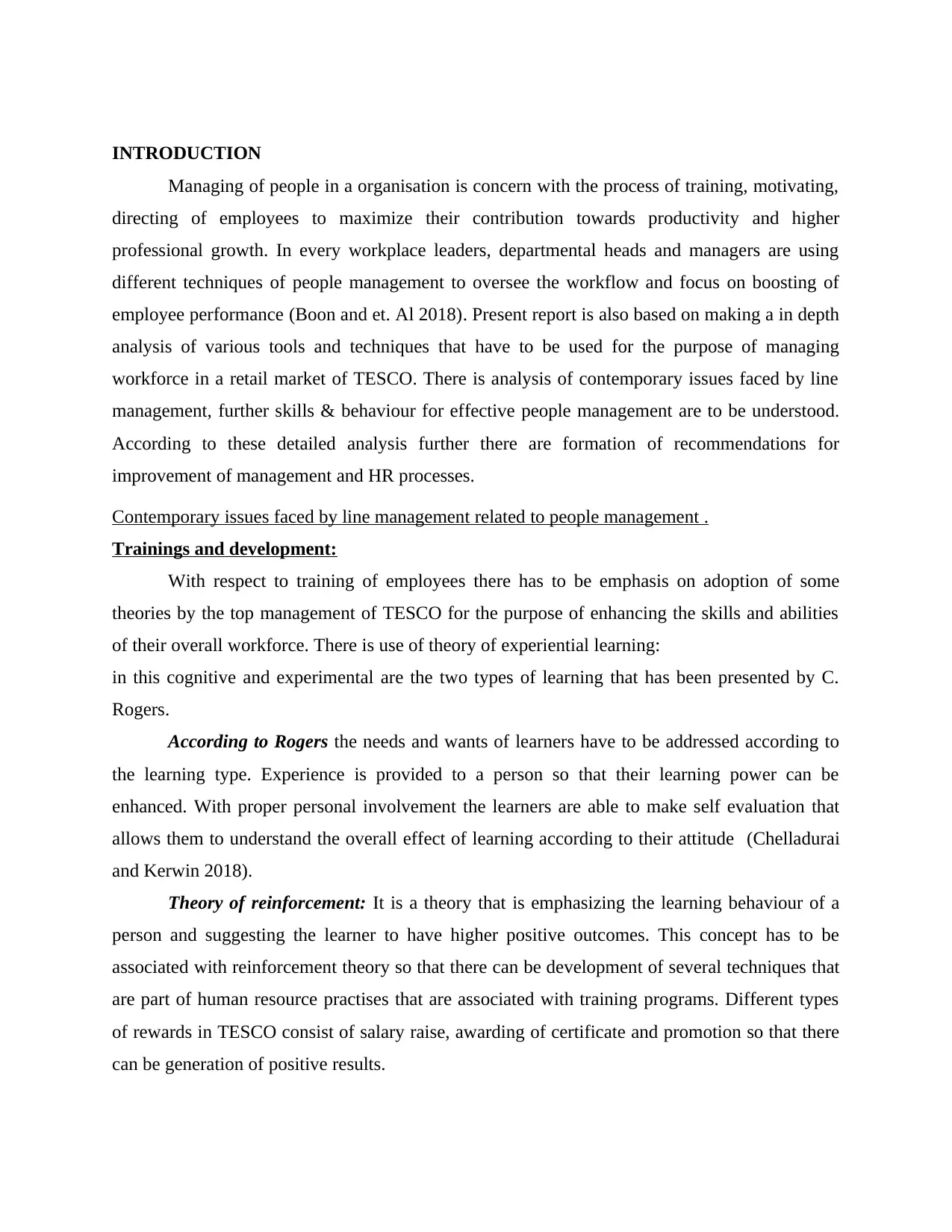
INTRODUCTION
Managing of people in a organisation is concern with the process of training, motivating,
directing of employees to maximize their contribution towards productivity and higher
professional growth. In every workplace leaders, departmental heads and managers are using
different techniques of people management to oversee the workflow and focus on boosting of
employee performance (Boon and et. Al 2018). Present report is also based on making a in depth
analysis of various tools and techniques that have to be used for the purpose of managing
workforce in a retail market of TESCO. There is analysis of contemporary issues faced by line
management, further skills & behaviour for effective people management are to be understood.
According to these detailed analysis further there are formation of recommendations for
improvement of management and HR processes.
Contemporary issues faced by line management related to people management .
Trainings and development:
With respect to training of employees there has to be emphasis on adoption of some
theories by the top management of TESCO for the purpose of enhancing the skills and abilities
of their overall workforce. There is use of theory of experiential learning:
in this cognitive and experimental are the two types of learning that has been presented by C.
Rogers.
According to Rogers the needs and wants of learners have to be addressed according to
the learning type. Experience is provided to a person so that their learning power can be
enhanced. With proper personal involvement the learners are able to make self evaluation that
allows them to understand the overall effect of learning according to their attitude (Chelladurai
and Kerwin 2018).
Theory of reinforcement: It is a theory that is emphasizing the learning behaviour of a
person and suggesting the learner to have higher positive outcomes. This concept has to be
associated with reinforcement theory so that there can be development of several techniques that
are part of human resource practises that are associated with training programs. Different types
of rewards in TESCO consist of salary raise, awarding of certificate and promotion so that there
can be generation of positive results.
Managing of people in a organisation is concern with the process of training, motivating,
directing of employees to maximize their contribution towards productivity and higher
professional growth. In every workplace leaders, departmental heads and managers are using
different techniques of people management to oversee the workflow and focus on boosting of
employee performance (Boon and et. Al 2018). Present report is also based on making a in depth
analysis of various tools and techniques that have to be used for the purpose of managing
workforce in a retail market of TESCO. There is analysis of contemporary issues faced by line
management, further skills & behaviour for effective people management are to be understood.
According to these detailed analysis further there are formation of recommendations for
improvement of management and HR processes.
Contemporary issues faced by line management related to people management .
Trainings and development:
With respect to training of employees there has to be emphasis on adoption of some
theories by the top management of TESCO for the purpose of enhancing the skills and abilities
of their overall workforce. There is use of theory of experiential learning:
in this cognitive and experimental are the two types of learning that has been presented by C.
Rogers.
According to Rogers the needs and wants of learners have to be addressed according to
the learning type. Experience is provided to a person so that their learning power can be
enhanced. With proper personal involvement the learners are able to make self evaluation that
allows them to understand the overall effect of learning according to their attitude (Chelladurai
and Kerwin 2018).
Theory of reinforcement: It is a theory that is emphasizing the learning behaviour of a
person and suggesting the learner to have higher positive outcomes. This concept has to be
associated with reinforcement theory so that there can be development of several techniques that
are part of human resource practises that are associated with training programs. Different types
of rewards in TESCO consist of salary raise, awarding of certificate and promotion so that there
can be generation of positive results.
⊘ This is a preview!⊘
Do you want full access?
Subscribe today to unlock all pages.

Trusted by 1+ million students worldwide
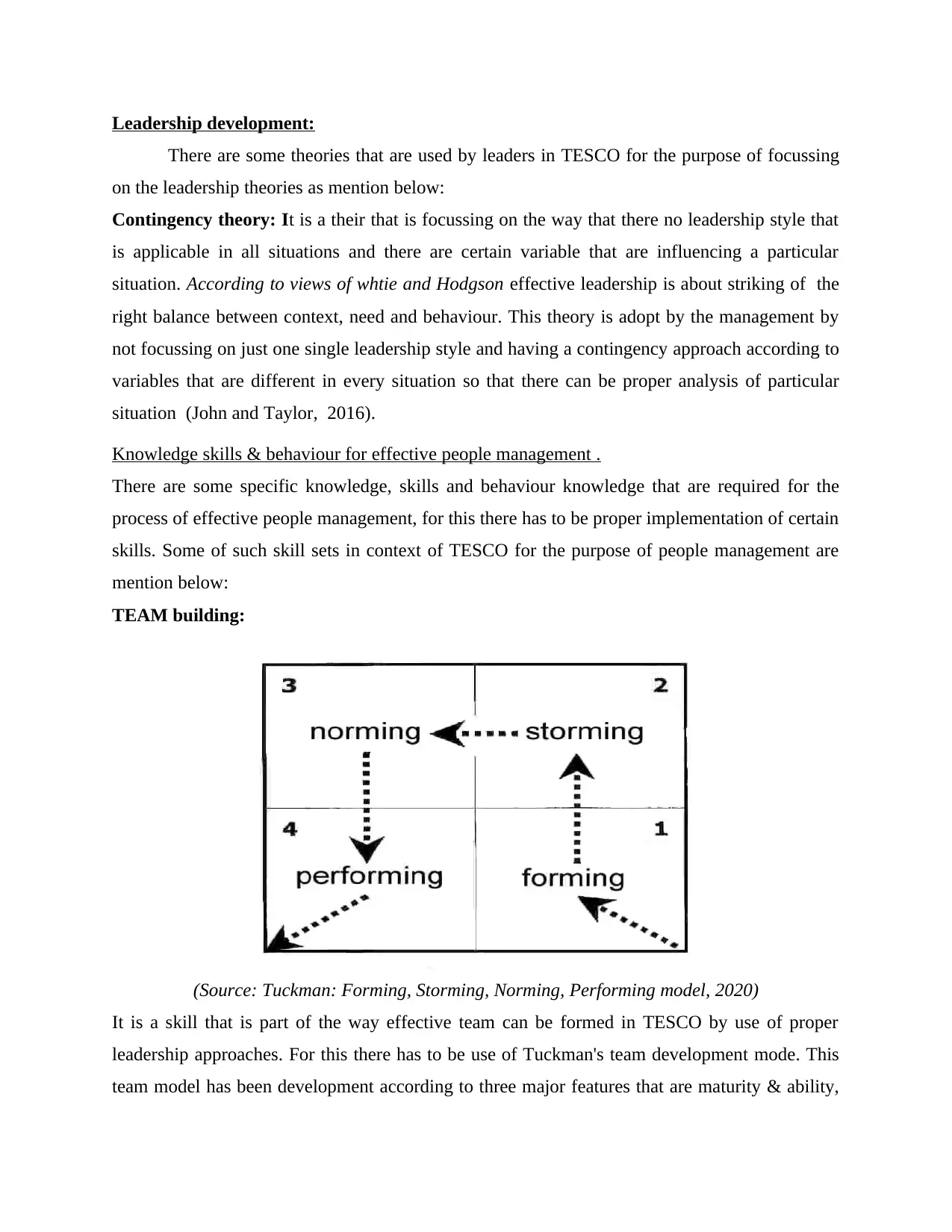
Leadership development:
There are some theories that are used by leaders in TESCO for the purpose of focussing
on the leadership theories as mention below:
Contingency theory: It is a their that is focussing on the way that there no leadership style that
is applicable in all situations and there are certain variable that are influencing a particular
situation. According to views of whtie and Hodgson effective leadership is about striking of the
right balance between context, need and behaviour. This theory is adopt by the management by
not focussing on just one single leadership style and having a contingency approach according to
variables that are different in every situation so that there can be proper analysis of particular
situation (John and Taylor, 2016).
Knowledge skills & behaviour for effective people management .
There are some specific knowledge, skills and behaviour knowledge that are required for the
process of effective people management, for this there has to be proper implementation of certain
skills. Some of such skill sets in context of TESCO for the purpose of people management are
mention below:
TEAM building:
(Source: Tuckman: Forming, Storming, Norming, Performing model, 2020)
It is a skill that is part of the way effective team can be formed in TESCO by use of proper
leadership approaches. For this there has to be use of Tuckman's team development mode. This
team model has been development according to three major features that are maturity & ability,
There are some theories that are used by leaders in TESCO for the purpose of focussing
on the leadership theories as mention below:
Contingency theory: It is a their that is focussing on the way that there no leadership style that
is applicable in all situations and there are certain variable that are influencing a particular
situation. According to views of whtie and Hodgson effective leadership is about striking of the
right balance between context, need and behaviour. This theory is adopt by the management by
not focussing on just one single leadership style and having a contingency approach according to
variables that are different in every situation so that there can be proper analysis of particular
situation (John and Taylor, 2016).
Knowledge skills & behaviour for effective people management .
There are some specific knowledge, skills and behaviour knowledge that are required for the
process of effective people management, for this there has to be proper implementation of certain
skills. Some of such skill sets in context of TESCO for the purpose of people management are
mention below:
TEAM building:
(Source: Tuckman: Forming, Storming, Norming, Performing model, 2020)
It is a skill that is part of the way effective team can be formed in TESCO by use of proper
leadership approaches. For this there has to be use of Tuckman's team development mode. This
team model has been development according to three major features that are maturity & ability,
Paraphrase This Document
Need a fresh take? Get an instant paraphrase of this document with our AI Paraphraser
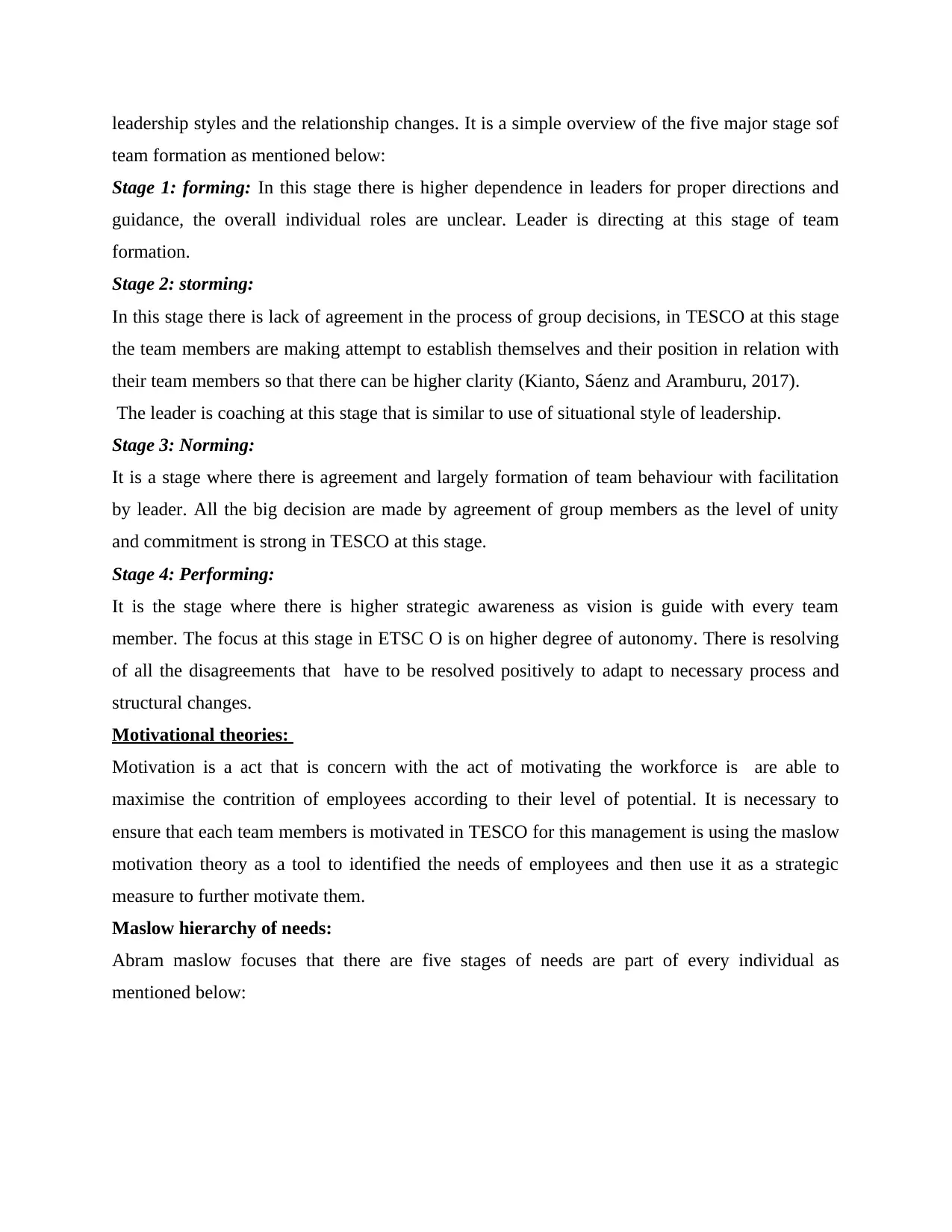
leadership styles and the relationship changes. It is a simple overview of the five major stage sof
team formation as mentioned below:
Stage 1: forming: In this stage there is higher dependence in leaders for proper directions and
guidance, the overall individual roles are unclear. Leader is directing at this stage of team
formation.
Stage 2: storming:
In this stage there is lack of agreement in the process of group decisions, in TESCO at this stage
the team members are making attempt to establish themselves and their position in relation with
their team members so that there can be higher clarity (Kianto, Sáenz and Aramburu, 2017).
The leader is coaching at this stage that is similar to use of situational style of leadership.
Stage 3: Norming:
It is a stage where there is agreement and largely formation of team behaviour with facilitation
by leader. All the big decision are made by agreement of group members as the level of unity
and commitment is strong in TESCO at this stage.
Stage 4: Performing:
It is the stage where there is higher strategic awareness as vision is guide with every team
member. The focus at this stage in ETSC O is on higher degree of autonomy. There is resolving
of all the disagreements that have to be resolved positively to adapt to necessary process and
structural changes.
Motivational theories:
Motivation is a act that is concern with the act of motivating the workforce is are able to
maximise the contrition of employees according to their level of potential. It is necessary to
ensure that each team members is motivated in TESCO for this management is using the maslow
motivation theory as a tool to identified the needs of employees and then use it as a strategic
measure to further motivate them.
Maslow hierarchy of needs:
Abram maslow focuses that there are five stages of needs are part of every individual as
mentioned below:
team formation as mentioned below:
Stage 1: forming: In this stage there is higher dependence in leaders for proper directions and
guidance, the overall individual roles are unclear. Leader is directing at this stage of team
formation.
Stage 2: storming:
In this stage there is lack of agreement in the process of group decisions, in TESCO at this stage
the team members are making attempt to establish themselves and their position in relation with
their team members so that there can be higher clarity (Kianto, Sáenz and Aramburu, 2017).
The leader is coaching at this stage that is similar to use of situational style of leadership.
Stage 3: Norming:
It is a stage where there is agreement and largely formation of team behaviour with facilitation
by leader. All the big decision are made by agreement of group members as the level of unity
and commitment is strong in TESCO at this stage.
Stage 4: Performing:
It is the stage where there is higher strategic awareness as vision is guide with every team
member. The focus at this stage in ETSC O is on higher degree of autonomy. There is resolving
of all the disagreements that have to be resolved positively to adapt to necessary process and
structural changes.
Motivational theories:
Motivation is a act that is concern with the act of motivating the workforce is are able to
maximise the contrition of employees according to their level of potential. It is necessary to
ensure that each team members is motivated in TESCO for this management is using the maslow
motivation theory as a tool to identified the needs of employees and then use it as a strategic
measure to further motivate them.
Maslow hierarchy of needs:
Abram maslow focuses that there are five stages of needs are part of every individual as
mentioned below:

(Source: Motivation Theories, 2020)
Physiological needs: these are part of survival necessities that includes food, shelter and water
without which a individual cannot survive.
Safety: these are the safety needs that consist of protection from deprivation, threats and other
type of dangers, it also includes the financial security in context of employee.
Social or belongingness needs: these needs are related to need for affiliation, association or
friendship with colleagues, friends that is also required to fulfil the social needs of a individual.
Self esteem needs: It is regarded as the need for recognition and respect. These needs are related
to employees realising the confidence in order to perform their job roles.
Self actualisation: It is the opportunity of personal development, fun/creativity and learning. It is
the highest level need of a individual that can aspire them to achieve certain laid objectives.
Above mentioned are the five stage that are used to motivate employees to enhance their
present level of contribution towards their job roles and job duties in TESCO. This theory is
applied in a way that present state of employees are identified so that they can be offer higher
level needs in order to motivate them to increase their contribution to achieve such higher level
of needs.
HR process and support management for effective performance management .
Performance management review:
Physiological needs: these are part of survival necessities that includes food, shelter and water
without which a individual cannot survive.
Safety: these are the safety needs that consist of protection from deprivation, threats and other
type of dangers, it also includes the financial security in context of employee.
Social or belongingness needs: these needs are related to need for affiliation, association or
friendship with colleagues, friends that is also required to fulfil the social needs of a individual.
Self esteem needs: It is regarded as the need for recognition and respect. These needs are related
to employees realising the confidence in order to perform their job roles.
Self actualisation: It is the opportunity of personal development, fun/creativity and learning. It is
the highest level need of a individual that can aspire them to achieve certain laid objectives.
Above mentioned are the five stage that are used to motivate employees to enhance their
present level of contribution towards their job roles and job duties in TESCO. This theory is
applied in a way that present state of employees are identified so that they can be offer higher
level needs in order to motivate them to increase their contribution to achieve such higher level
of needs.
HR process and support management for effective performance management .
Performance management review:
⊘ This is a preview!⊘
Do you want full access?
Subscribe today to unlock all pages.

Trusted by 1+ million students worldwide

performance management is regarded as a concept of managing human resources in
organisations. It is a continuous process where there is identification, measurement and further
development of individual performance so that there can be alignment with the overall
performance of organisation.
For the purpose of effective process of performance market there are three basic concepts that
are taken into consideration as mentioned below:
Goal setting theory Control theory Social cognitive theory
In this there has to be use of
specific goals in order to focus
on creation of strong situations
that are very crucial for
Most performance
management techniques are
not able to emphasize on the
feedback, performers have to
This is a their where
employees are capable of
performing higher to achieve
the difficult level goals laid
organisations. It is a continuous process where there is identification, measurement and further
development of individual performance so that there can be alignment with the overall
performance of organisation.
For the purpose of effective process of performance market there are three basic concepts that
are taken into consideration as mentioned below:
Goal setting theory Control theory Social cognitive theory
In this there has to be use of
specific goals in order to focus
on creation of strong situations
that are very crucial for
Most performance
management techniques are
not able to emphasize on the
feedback, performers have to
This is a their where
employees are capable of
performing higher to achieve
the difficult level goals laid
Paraphrase This Document
Need a fresh take? Get an instant paraphrase of this document with our AI Paraphraser

substantial achievement of laid
objectives. In TESCO it can be
pointed out that the performer
participation is increased by
focussing on targeting of the
power of goal commitment.
take in charge of the own
feedback loops that assist them
to focus on negative
discrepancy achievements.
down by top management. In
this the self efficacy is
focussing on higher gaols so
that there can be higher
perseverance & resilience.
Human resource professionals in TESCO are focussing on above discussed techniques of
professional Management for the purpose of ensuring that employees are able to maximize their
contribution towards strategic goals of top management that is overall laid vision and mission of
the organisation.
360 degree appraisal: It is a appraisal technique that is used as a performance appraisal methods
in organisation since 1940s. It is a method that is providing each employee a opportunity to
receive feedback from their superiors regarding timely availing of opportunity to review
feedbacks from their superiors, staff members, customers and co workers. It is a performance
assessment tool that is incorporated to asses the performance of a candidate (Mond and
Martocchio, 2016). This tool is used at both senior and middle level. In TESCO there is focus on
use of 360 degree as a tool for making a detailed assessment of the staff potential and
performance so that there can be 360 degree assessment before taking all the major decisions in
the organisations. The results drawn from such analysis are then further used as mentioned
below:
objectives. In TESCO it can be
pointed out that the performer
participation is increased by
focussing on targeting of the
power of goal commitment.
take in charge of the own
feedback loops that assist them
to focus on negative
discrepancy achievements.
down by top management. In
this the self efficacy is
focussing on higher gaols so
that there can be higher
perseverance & resilience.
Human resource professionals in TESCO are focussing on above discussed techniques of
professional Management for the purpose of ensuring that employees are able to maximize their
contribution towards strategic goals of top management that is overall laid vision and mission of
the organisation.
360 degree appraisal: It is a appraisal technique that is used as a performance appraisal methods
in organisation since 1940s. It is a method that is providing each employee a opportunity to
receive feedback from their superiors regarding timely availing of opportunity to review
feedbacks from their superiors, staff members, customers and co workers. It is a performance
assessment tool that is incorporated to asses the performance of a candidate (Mond and
Martocchio, 2016). This tool is used at both senior and middle level. In TESCO there is focus on
use of 360 degree as a tool for making a detailed assessment of the staff potential and
performance so that there can be 360 degree assessment before taking all the major decisions in
the organisations. The results drawn from such analysis are then further used as mentioned
below:
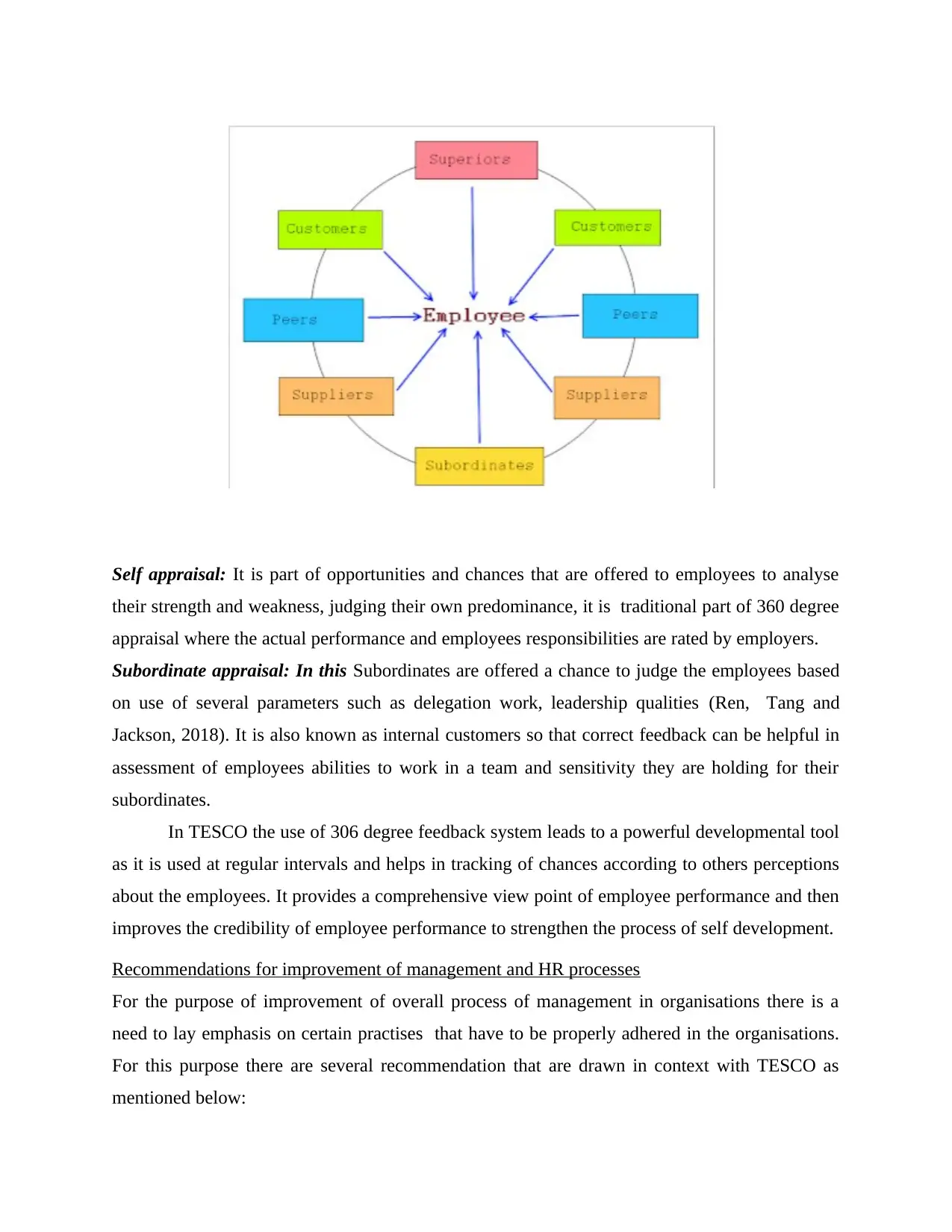
Self appraisal: It is part of opportunities and chances that are offered to employees to analyse
their strength and weakness, judging their own predominance, it is traditional part of 360 degree
appraisal where the actual performance and employees responsibilities are rated by employers.
Subordinate appraisal: In this Subordinates are offered a chance to judge the employees based
on use of several parameters such as delegation work, leadership qualities (Ren, Tang and
Jackson, 2018). It is also known as internal customers so that correct feedback can be helpful in
assessment of employees abilities to work in a team and sensitivity they are holding for their
subordinates.
In TESCO the use of 306 degree feedback system leads to a powerful developmental tool
as it is used at regular intervals and helps in tracking of chances according to others perceptions
about the employees. It provides a comprehensive view point of employee performance and then
improves the credibility of employee performance to strengthen the process of self development.
Recommendations for improvement of management and HR processes
For the purpose of improvement of overall process of management in organisations there is a
need to lay emphasis on certain practises that have to be properly adhered in the organisations.
For this purpose there are several recommendation that are drawn in context with TESCO as
mentioned below:
their strength and weakness, judging their own predominance, it is traditional part of 360 degree
appraisal where the actual performance and employees responsibilities are rated by employers.
Subordinate appraisal: In this Subordinates are offered a chance to judge the employees based
on use of several parameters such as delegation work, leadership qualities (Ren, Tang and
Jackson, 2018). It is also known as internal customers so that correct feedback can be helpful in
assessment of employees abilities to work in a team and sensitivity they are holding for their
subordinates.
In TESCO the use of 306 degree feedback system leads to a powerful developmental tool
as it is used at regular intervals and helps in tracking of chances according to others perceptions
about the employees. It provides a comprehensive view point of employee performance and then
improves the credibility of employee performance to strengthen the process of self development.
Recommendations for improvement of management and HR processes
For the purpose of improvement of overall process of management in organisations there is a
need to lay emphasis on certain practises that have to be properly adhered in the organisations.
For this purpose there are several recommendation that are drawn in context with TESCO as
mentioned below:
⊘ This is a preview!⊘
Do you want full access?
Subscribe today to unlock all pages.

Trusted by 1+ million students worldwide

Development of employee feedback: There is a requirement that employers are able to
make a employee handbook that is based in proper compliance of human resources
practises. It has to be in adherence with the management and human resource practises so
that there can be development of insights of company expectations (Soltis, Brass, and
Lepak, 2018). Development of job deceptions: The job description is one of the crucial part that Consist
of hiring of employees, their orientation, employee performance management. In respect
with TESCO management has to ensure that there is a proper copy of job description that
has to be signed so that there can be a detail overview of the job duties, roles &
responsibilities by employers (Shen and Benson, 2016).
Development of a evaluation performance: The overall performance evaluation process
has to be destined to check whether all the efforts of employers are according to the
requirements and set standards of performance. This methods is very crucial in analysing
the present level of performance so that further attempts can be made in the Ares where
the performance is lacking behind to manage the employees in more effective manner.
make a employee handbook that is based in proper compliance of human resources
practises. It has to be in adherence with the management and human resource practises so
that there can be development of insights of company expectations (Soltis, Brass, and
Lepak, 2018). Development of job deceptions: The job description is one of the crucial part that Consist
of hiring of employees, their orientation, employee performance management. In respect
with TESCO management has to ensure that there is a proper copy of job description that
has to be signed so that there can be a detail overview of the job duties, roles &
responsibilities by employers (Shen and Benson, 2016).
Development of a evaluation performance: The overall performance evaluation process
has to be destined to check whether all the efforts of employers are according to the
requirements and set standards of performance. This methods is very crucial in analysing
the present level of performance so that further attempts can be made in the Ares where
the performance is lacking behind to manage the employees in more effective manner.
Paraphrase This Document
Need a fresh take? Get an instant paraphrase of this document with our AI Paraphraser

CONCLUSION
From the above made analysis it can be summarized that there are different associated
practises with the process of employee management in the organisation that have to be
performed by employers in order to ensure that there is higher productivity on part of employees.
There has to be use of appropriate theories so that there can be effectiveness in the overall
process of motivating employees and managing them to enhance their level of skills &
performance.
From the above made analysis it can be summarized that there are different associated
practises with the process of employee management in the organisation that have to be
performed by employers in order to ensure that there is higher productivity on part of employees.
There has to be use of appropriate theories so that there can be effectiveness in the overall
process of motivating employees and managing them to enhance their level of skills &
performance.
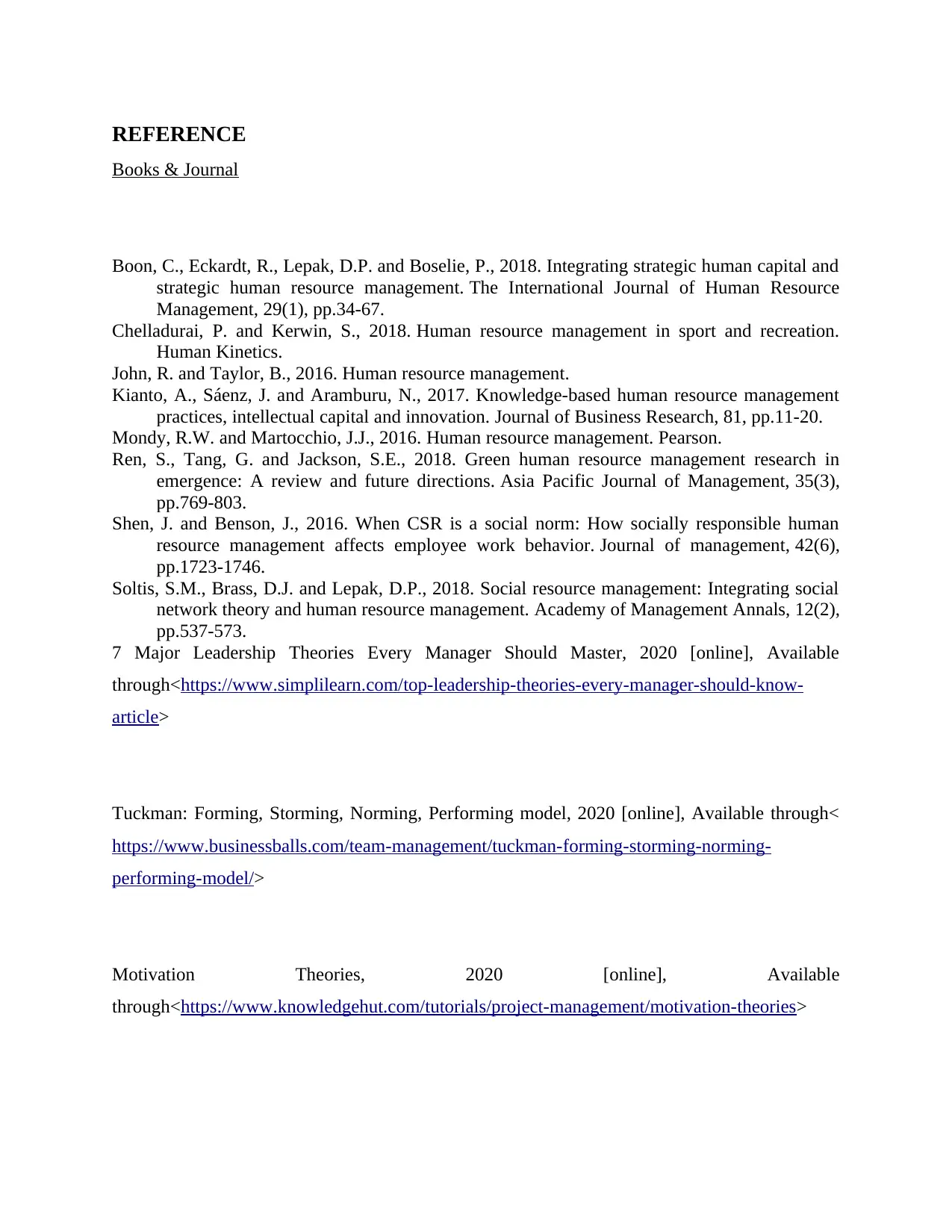
REFERENCE
Books & Journal
Boon, C., Eckardt, R., Lepak, D.P. and Boselie, P., 2018. Integrating strategic human capital and
strategic human resource management. The International Journal of Human Resource
Management, 29(1), pp.34-67.
Chelladurai, P. and Kerwin, S., 2018. Human resource management in sport and recreation.
Human Kinetics.
John, R. and Taylor, B., 2016. Human resource management.
Kianto, A., Sáenz, J. and Aramburu, N., 2017. Knowledge-based human resource management
practices, intellectual capital and innovation. Journal of Business Research, 81, pp.11-20.
Mondy, R.W. and Martocchio, J.J., 2016. Human resource management. Pearson.
Ren, S., Tang, G. and Jackson, S.E., 2018. Green human resource management research in
emergence: A review and future directions. Asia Pacific Journal of Management, 35(3),
pp.769-803.
Shen, J. and Benson, J., 2016. When CSR is a social norm: How socially responsible human
resource management affects employee work behavior. Journal of management, 42(6),
pp.1723-1746.
Soltis, S.M., Brass, D.J. and Lepak, D.P., 2018. Social resource management: Integrating social
network theory and human resource management. Academy of Management Annals, 12(2),
pp.537-573.
7 Major Leadership Theories Every Manager Should Master, 2020 [online], Available
through<https://www.simplilearn.com/top-leadership-theories-every-manager-should-know-
article>
Tuckman: Forming, Storming, Norming, Performing model, 2020 [online], Available through<
https://www.businessballs.com/team-management/tuckman-forming-storming-norming-
performing-model/>
Motivation Theories, 2020 [online], Available
through<https://www.knowledgehut.com/tutorials/project-management/motivation-theories>
Books & Journal
Boon, C., Eckardt, R., Lepak, D.P. and Boselie, P., 2018. Integrating strategic human capital and
strategic human resource management. The International Journal of Human Resource
Management, 29(1), pp.34-67.
Chelladurai, P. and Kerwin, S., 2018. Human resource management in sport and recreation.
Human Kinetics.
John, R. and Taylor, B., 2016. Human resource management.
Kianto, A., Sáenz, J. and Aramburu, N., 2017. Knowledge-based human resource management
practices, intellectual capital and innovation. Journal of Business Research, 81, pp.11-20.
Mondy, R.W. and Martocchio, J.J., 2016. Human resource management. Pearson.
Ren, S., Tang, G. and Jackson, S.E., 2018. Green human resource management research in
emergence: A review and future directions. Asia Pacific Journal of Management, 35(3),
pp.769-803.
Shen, J. and Benson, J., 2016. When CSR is a social norm: How socially responsible human
resource management affects employee work behavior. Journal of management, 42(6),
pp.1723-1746.
Soltis, S.M., Brass, D.J. and Lepak, D.P., 2018. Social resource management: Integrating social
network theory and human resource management. Academy of Management Annals, 12(2),
pp.537-573.
7 Major Leadership Theories Every Manager Should Master, 2020 [online], Available
through<https://www.simplilearn.com/top-leadership-theories-every-manager-should-know-
article>
Tuckman: Forming, Storming, Norming, Performing model, 2020 [online], Available through<
https://www.businessballs.com/team-management/tuckman-forming-storming-norming-
performing-model/>
Motivation Theories, 2020 [online], Available
through<https://www.knowledgehut.com/tutorials/project-management/motivation-theories>
⊘ This is a preview!⊘
Do you want full access?
Subscribe today to unlock all pages.

Trusted by 1+ million students worldwide
1 out of 12
Related Documents
Your All-in-One AI-Powered Toolkit for Academic Success.
+13062052269
info@desklib.com
Available 24*7 on WhatsApp / Email
![[object Object]](/_next/static/media/star-bottom.7253800d.svg)
Unlock your academic potential
Copyright © 2020–2025 A2Z Services. All Rights Reserved. Developed and managed by ZUCOL.





